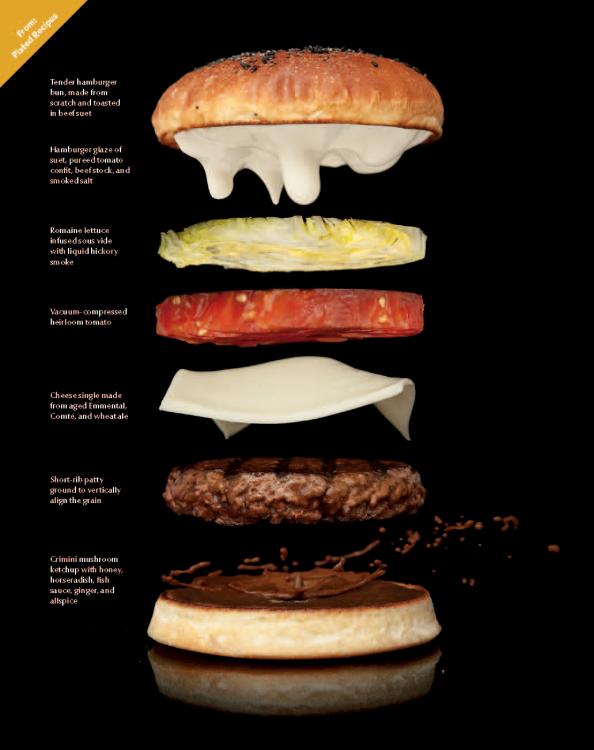-
Posts
8,089 -
Joined
-
Last visited
Content Type
Profiles
Forums
Store
Help Articles
Everything posted by Dave the Cook
-
Pretty much all those tests show is the difference in performance between jar designs when used to do an arbitrary task. (I'm not sure what it matters that you can liquify a whole orange, anyway. Is this a common smoothie ingredient?) Pick a different ingredient -- strawberries or bananas -- and you'd probably get very different results. I'd also point out that their failure to read the manuals caused the VitaMix and Blendtec to appear to be less capable than they actually were. I guess if you're buying an appliance to pulverize whole fruits the size of apples and oranges, then you should get the KitchenAid. But I can tell you from experience that it's not a very good blender.
-
Too bad all of them most of them suck.
-

Intellectual Property, Copyright & Cocktails
Dave the Cook replied to a topic in Food Traditions & Culture
Jerry Thomas's work is in the public domain, so both DeGroff and Peek would be off the infringement hook. -
One of the panelists, Vickie Kloeris, has been with the ISS food program for 20 years, and almost certainly can make such predictions. As it happens, Vickie participated in a fascinating symposium back in 2004. You can read it here: eGullet Q&A with NASA Food Scientist Vickie Kloeris.
-
I think Chris is talking about the wok burners that some gas cooktop manufacturers feature. Those have BTU outputs in the 20K to to 25KBTU range -- not really enough for good wok cookery.
-
Mine stays on a long time, too--at least 20 seconds. Could have been three or five seconds. I was teaching a class, so precise timing wasn't uppermost in my mind, but there's no way would it have waited on me for 20 seconds. As for why, I suppose it varies by brand (this was a Miele), and perhaps it's even programmable.
-
A lot of us fancy ourselves fancy cooks! For flambé, I'd use one of those butane-powered barbecue lighters like this one, which looks classy enough for indoor use. Lifting and tossing can be a problem on induction. I was working on an induction unit just last night, and concluded that I had about a second of non-contact time before the range decided that there was no longer a pan on the burner and turned itself off. If I had an induction cooktop at home, I'd probably have to retrain myself. For the benefit of others' concerns here, I'll also point out that since induction relies on contact, warped pans and pans with lips or ridges on the bottom are problematic. The former heats only where the pan is flat, which can lead to unexpected performance issues; the latter won't work at all (that includes most any reversible grill/griddle and some cast-iron skillets). ETA: I've never used a standalone induction wok burner, but I remember being pretty impressed with one Ming Tsai used on his show a few years back.
-
Well, there's soubise, a classic French sauce that combines onion puree with bechamel (I think that's right). In Cookwise, Corriher uses pureed shallots to thicken a sauce, but I can't remember which one, and my copy of the book is sequestered behind an antique sideboard and the rear seats from a 1985 BMW. Finally, I made a curry the other night that called for tossing onion quarters, yogurt and a buttload of spices into a blender and running it until everything was smooth.
-
I got a club once with ham in place of turkey - "what's this?" I said - "that's the way we make it" they replied. Couldn't eat it - I was in the mood for a club and that was not, not, not a club! Ruined my day! Case in point: almost all of the earliest recipes for club sandwiches call not for turkey but chicken, and were single-layer affairs. The third slice of toast didn't become the standard until the '30s.
-
Perhaps because, as you say, they're pretty fresh.
-
We need more info. Cottage where? Shopping options? Local specialties? Your strengths and your guests' preferences? Prep assistance available?
-
McGee points out (p 88) that fresher is better. The white will still be thick and the chalazae nice and taut. This increases your odds of a centered yolk. Other methods, like side-resting, bottom-resting and spinning, he reports to be unreliable. Of course, fresh eggs are often harder to peel . . .
-

MxMo August 2010: Brown, Bitter, and Stirred
Dave the Cook replied to a topic in Spirits & Cocktails
Any hints on a substitute for the Plantation? I've got a variety of rums, but not that one. -
Depends on how successful one is in making decent home-made stock. Also depends on the recipe.
-
I think there is some confusion here (or maybe I am the one who is confused)... Some people are talking about the automatic ice makers that are incorporated into kitchen freezers. As I understand it, Dave is talking about stand-alone home ice makers that don't do anything but make ice. These are two meaningfully different situations. Sam is correct. I apologize if I wasn't clear. I have a perfectly adequate automatic ice maker in my freezer. But here's the thing: the going rate for a retrofit ice maker kit for an upright fridge is around $120. For what by comparison is chump change, it makes ice that is far superior -- though not what I would call great ice -- to a $1300 dedicated unit. Yeah, you could get a Kold Draft Ice Butler, but that's three grand, and comes with (last I heard) service issues. I don't understand why no one simply improves on the ice maker kit design, giving it more molds, a faster cycle time, and a larger bin. How that could cost more that the inferior ice makers on the market now? I don't follow. The half-moons that come out of my ice maker are fully frozen.
-
I'd agree, except 100% of the ice makers I've encountered have the same problem. If you look that the manual for that Whirlpool (page 11 of this document), you'll notice that there isn't even a temperature setting -- nor, in my mind, need there be, if the default temperature is correct.
-
In the last year, I've had experience with four different stand-alone ice makers designed for home use. Without exception, every one failed at what I think should be the purpose of such an appliance: to make dry, substantial cubes in large quantities. None of these were cheap appliances (Sub-Zero, Scottsman); at a beach rental a few weeks ago, I encountered a $1300 Whirlpool that made round-shouldered 3/8" cubes swimming in water. Nice and clear, but in no way as suitable for shaking cocktails or chilling items as those made by the kit in the refrigerator (which probably cost about the same and also managed to keep a lot of food nicely chilled), or, for that matter, in the freezer of the Kenmore I've got at home. I'm not exactly in the market for an ice maker, but I wonder why anyone would invest so much money in a device that seems designed to fail at its only mission. On the other hand, if someone could point me to a home unit that actually made good ice, I might become a prospect. Anyone have experience -- good or bad, but especially good -- with these contraptions?
-
I'm not sure how that follows, Pam. UK regulations don't require labeling of injected water, whereas in the US, there is no pure water injection, and anything else must be declared on the label.
-
Chickens are not injected with water in the US. They may be "enhanced" with a salt/flavoring solution (which is, admittedly, mostly water), but this must be stated on the label. Similarly, water chilling can lead to extra water in the product. But again, this must be declared. Per the USDA:
-
Anything that sits close to the counter and is powerful enough to be worthwhile is also going to cast harsh shadows that your over-the-shoulder ceiling lamp won't be able to mitigate. A hundred bucks is pretty tight. What about an old drafting lamp or a reproduction of same? Something like this or a couple of these. Garage sales or junk shops might turn up something more authentic. A little paint, simple rewiring, and Bob's your uncle.
-
I'm a fan of undercabinet lighting, but that's not going to work in this case, as there's no cabinet over the work area. Instead, I'd be looking at a set of small hanging lamps with retro shades. I found some at rejuvenation.com and more at good old Lighting Direct. Some of the designs are silly (IMO), but you can probably find something to match whatever you've replaced that chandelier with, without upstaging it. If you're like me, you'll want more light than the three 60-watt bulbs most of those use. But since watt limits are usually related to heat, you can replace the incandescents with brighter but cooler running screw-in fluorescents.
-

[PLAN] eGullet Classic Cocktails Workshop in Providence
Dave the Cook replied to a topic in New England: Dining
A complimentary and informative article on the workshop popped up on the Go Local Prov site. Read the entire piece here. -
Over in the "Tips for Determining Produce Quality" topic, a side discussion developed. It starts here. This important debate deserves its own measured, probing and considerate debate. Even though thin clearly sucks.
-
A few tips we give our students: If you want to know which fruit is likely to be good, stand in the middle of the produce section and take a deep breath. Buy whatever you can smell. When produce is cheap, that almost always means it's in season. Don't buy citrus by color, because packers and producers often dye it. Buy by weight and squeezability.
-

"Modernist Cuisine" by Myhrvold, Young & Bilet (Part 1)
Dave the Cook replied to a topic in Cookbooks & References
The full table of contents lists 48 recipes in the "Plated Dishes" volume. But as Nathan has alluded, that number is a little deceptive. The Mushroom Swiss Burger, for example, incorporates 16 subrecipes: Methylcellulose A15C Stock Solution Tomato Confit Rendered Beef Suet Short-Rib Patty Hamburger Buns Mushroom Broth Freeze-Dried Shiitake Mushroom Ketchup Restructured Emmental Slices Onion Stock Onion Cracker Breading Shallot Rings Hamburger Glaze Sautéed Maitake Mushrooms Smoked Lettuce Compressed Tomatoes So it's easy to see how a recipe count not only multiplies, but how difficult it is to count them -- some are barely recipes in the classical sense, and some seem to be quite complicated. Speaking of the burger, here's a larger version of what you can see on the site (this is at 100 dpi; obviously the printed version will be nice and sharp):


